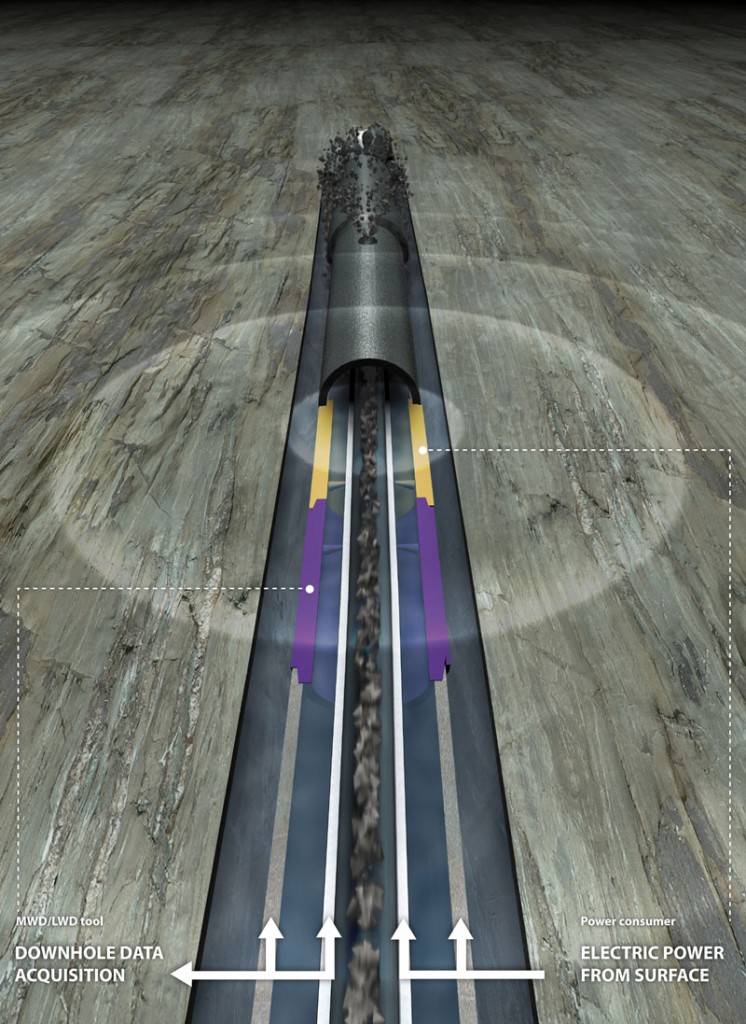Reelwell telemetry system enables high-speed two-way data transmission
The Reelwell Telemetry System (RTS) was developed in combination with the Reelwell Drilling Method by using the drilling method’s inner dual concentric drill string as an electrical conductor. Reelwell expects to commercialize the telemetry sytem during the fourth quarter this year.
The Reelwell Drilling Method (RDM) is based on a concentric dual drill string closed circulation system. A dual float valve and a piston secures fulltime pressure control during drilling and pipe connections. The piston prevents the annular fluid from being lost and also provides the downhole hydraulic weight on bit (WOB) for increased reach when drilling horizontal sections. Drill cuttings are removed from the wellbore just behind the drill bit and routed back to the surface via the inner string, resulting in clean hole conditions.
The RDM secures accurate pressure management and improved well control through closed loop fluid circulation, making it especially attractive for managed pressure drilling (MPD). The system configuration also represents substantial potential for pushing present limitations in extended reach drilling through hydraulic weight on bit.
With all circulation being confined in the dual drill string, the new method may push existing deepwater limits through riserless drilling, the company said.

High rate, real-time data transmission
The real-time RTS enables two-way high speed data communications to downhole MWD and LWD tools as well as providing the ability to transfer large amounts of electric power to downhole tools. The RTS comprises a unique stab-in connector design mounted in the drillpipe toolboxes and advanced transceiver technology that sends and receives sensor data.
The connector system provides three important functions in a robust and space saving design: electrical insulation, high pressure seal and low impedance electrical contact. The drill pipe can be handled like any other drill pipe because the RTS is contained inside the dual drilling string.
“The idea (for RTS) began with the dual drill string that became a conductor,” said Ove Hole, Sales and Marketing Manager for Reelwell in Stavanger.
“The driver for the telemetry system was the dual drill pipe which acts as a cable that we can use to transmit signals downhole and receive signals at the surface,” Mr Hole said. “The cross section area of the inner pipe is huge compared with any other cables the industry is presently using to transmit data.”
A big advantage of the dual drill string with RTS is capability of high real time data transmission capacity, Mr Hole noted. “We can send and receive LWD information at a much higher bandwidth, resulting in real-time data,” he explained. “The data can be tapped directly into a computer to be used immediately in any drilling management system.”
The high data bandwidth allows any combination of downhole sensors to be monitored continuously. Additionally, the power supply capability exceeds the requirements of signal transmission for all existing sensor or directional drilling tools.
“We developed the software for the RTS and built temperature and pressure gauges, which are part of the drill string,” Mr Hole said.
The inner string is electrically insulated from the outerpipe, preventing conductivity between the two pipes.
High speed data transmission
Transceivers utilize digital signal processing technologies to optimize signal transmission. The transmitted data is made redundant by duplication and interleaving to optimize signal transmission, making the system immune to all noise sources.
The transceiver technology to transmit sensor data and the digital signal processing technology enable simultaneous two-way communication. The technologies also provide the ability to transfer power to downhole tools, including downhole electric motors.
The data transmission rate is in the range of Megabytes per second. This high transmission rate exceeds the requirements of any sensor packages in the industry, thus, enabling transmission of seismic data in real-time.
Data can be transmitted in any situation such as pump shutdown, tripping out of the hole, and drilling fluid circulation stat and stop. This increases safety as the potential for experiencing a kick when tripping out of the hole may be reduced by continuously monitoring the bottomhole parameters.
In one full scale drilling test conducted in March 2009, the monitored data provided by the RTS was identical to the data retrieved from a Baker Hughes memory log that was part of the bottomhole assembly (BHA). This test proved the accuracy of the data transmitted in real-time.




